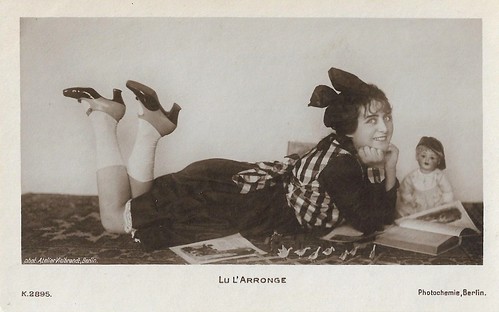 German postcard by NPG, no. 1068. Photo: Zander & Labisch, Berlin.
German postcard by NPG, no. 1068. Photo: Zander & Labisch, Berlin.
German postcard by Rotophot in the Film-Sterne series, no. 225/1, 1919-1924.
Half a woman, half a girl
Five years ago, when I wrote the first version of this post, there were some star postcards to prove that Lu L'Arronge must have been a well-known actress at the time, but that surprisingly little was known about her. This has changed since then. Thanks to the sources mentioned below, we can now tell a bit more about Lu's life and work. But a lot still stays unclear.
Lu L'Arronge was born in a Jewish family of actors, directors and playwrights. She was a distant relative to the playwright, critic and theatre manager Adolf L'Arronge (1838-1908), although the exact family ties are unclear. Adolf L'Arronge's father, the actor and theatre director Theodor Eberhard changed his name from Aaronsohn to L'Arronge. Though IMDb gives the life dates of 1901-1991 for Lu L'Arronge, Stephanie D'Heil at Steffi-Line remarks that this is an error and that the dates are linked to another actress, Lia L'Arronge, originally Lia Fricke, and married to Gerhart L'Arronge.
According to IMDb's trivia section: "The actress Lu L'Arronge cherished early the wish to become a stage actress. Not least because her grandfather belonged to the founders of the Bühnengenossenschaft and her father's cousin was the well-known stage writer Adolf L'Arronge." This is based on L'Arronge's own words in the volume Die Frau im Film 1919 (The Woman in Film 1919), a series of short interviews with German actresses of that time. At an early age, Lu cherished the wish to become a stage actress, but her mother didn't accept that her daughter would become an actress. When the German film industry became 'modern' during World War I and conquered a huge public, Lu's wish to become an actress returned and she knew to convince her mother.
Thomas Schaedeli writes at his site Cyranos that Lu conquered the big screen from 1917 on. She played in films like Die Schlange der Kleopatra/The Serpent of Cleopatra (1917), Lu's Backfischzeit/Lu's Backfisch Times (1917), Lu'chens Verlobung am Gartentor/Little Lu's engagement at the garden gate (1917), s'Liserl vom Loischtal (1917) and Kain (1918). These films were mainly produced by Franz Schmelter, who also was her regular director, starting with Die Schlange der Kleopatra (1917) and Lu'chens Verlobung am Gartentor (1917)
Schaedeli adds that she finally founded her own company in 1919, to star in films including Wenn's Landlüferl weht/When the country breeze blows (1918), Anna Karenina (1919), Die weisse Maus/The White Mouse (1919), and Die Geisterbraut/The Ghost Bride (1919).

German postcard by Photochemie, Berlin, no. K.2145. Photo by Zander u. Labisch, Berlin.

German postcard by Verlag Hermann Leiser, Berlin, no. 5655. Photo: Zander & Labisch.

German postcard by Photochemie, Berlin, no. K.2895. Photo: Atelier Vielbrandt, Berlin.
The Ghost Bride
IMDb shows that Lu's production company L'Arronge Film GmbH was already founded in 1917 for the comedy Lu's Backfischzeit/Lu's Backfisch times (Franz Schmelter, 1917). L'Arronge Film GmbH produced 9 films including Wenn's Landlüferl weht/When the country breeze blows (Karl Moos, 1918), and Die weisse Maus/The White Mouse (Leonhard Haskel, 1919), but then the film company halted. In her 'Backfisch' (teenager) comedies, Anna Müller-Lincke was a regular performer.
She appeared also in Die Geisterbraut/The Ghost Bride (Herbert Gerdes, 1920), produced by Georg Alexander's company Neue Berliner Film. But L'Arronge's screen career quickly went downhill.
In the Leo Tolstoy adaptation Anna Karenina (Friedrich Zelnik/Frederic Zelnik, 1920), Lu only had a minor part. The Star of the film was Lya Mara and the film was produced by her and her husband-director's company Zelnik-Mara-Film. It must have been Lu's final film.
A few years before, Lu was interviewed for the publication Die Frau im Film 1919 (The Woman in Film 1919), in which several female stars of the silent German cinema (including Erna Morena, Pola Negri, Lya Mara) answered questions about their work. Lu said that she had "the big luck to be engaged at a new-created firm, for one year, for which I gave my name. Here I prefer to play the high-spirited teenager things, half a woman, half a girl."
IMDd lists that Lu L'Arronge acted during her career in 15 films between 1917 and 1920 and that she produced 9 films. What happened with Lu after her film dream was over?

German postcard by Photochemie, Berlin, no. K.1905. Photo: Alex Binder, Berlin.

German postcard by Photochemie, Berlin, no. K.1906. Photo: Alex Binder, Berlin.

German postcard by Verlag Hermann Leiser, Berlin, no. 501. Photo: Zander & Labisch.
Sources: Stephanie D'heil (Steffi-Line - German), Thomas Staedeli (Cyranos), Die Frau im Film 1919, Filmportal.de, and IMDb.
No comments:
Post a Comment